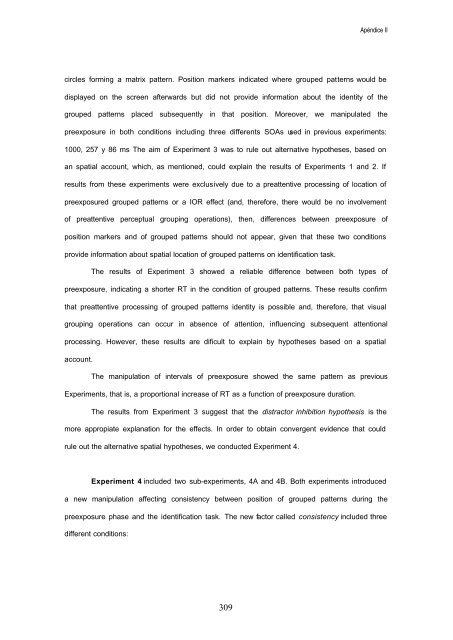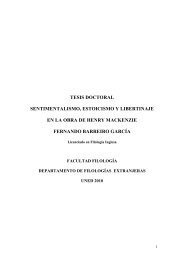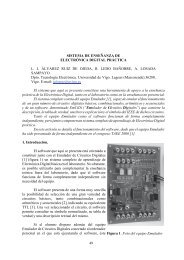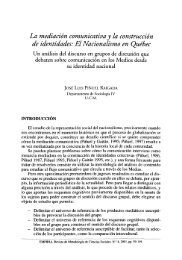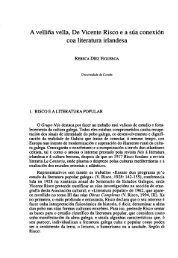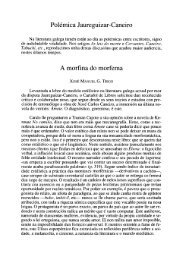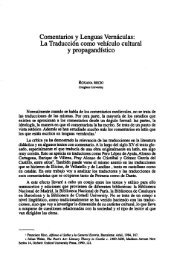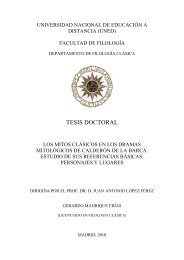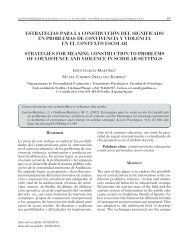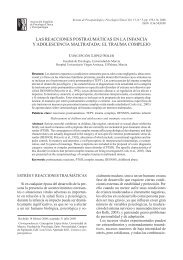- Page 1:
TESIS DOCTORAL ORGANIZACIÓN PERCEP
- Page 5:
En general, puede afirmarse que no
- Page 8 and 9:
VIII
- Page 10 and 11:
Gracias, María José Pedraja, por
- Page 12 and 13:
Gracias, Belén Jiménez, por tu co
- Page 14 and 15:
Capítulo 2 PROCESAMIENTO VISUAL PR
- Page 16 and 17:
4.4.3. Condición de control inters
- Page 18 and 19:
XVIII
- Page 21 and 22:
LISTA DE FIGURAS Figura 1. Caracter
- Page 23 and 24:
Figura 28. Medias de latencia de re
- Page 25 and 26:
LISTA DE TABLAS Tabla 1. Distribuci
- Page 27 and 28:
1 INTRODUCCIÓN
- Page 29 and 30:
INTRODUCCIÓN 3 Introducción En oc
- Page 31 and 32:
5 Introducción 1997; Russell y Dri
- Page 33 and 34:
7 Capítulo 1 Organización percept
- Page 35 and 36:
Capítulo 1 9 Capítulo 1. Organiza
- Page 37 and 38:
11 Capítulo 1. Organización perce
- Page 39 and 40:
13 Capítulo 1. Organización perce
- Page 41 and 42:
15 Capítulo 1. Organización perce
- Page 43 and 44:
Buena continuación Cierre 17 Capí
- Page 45 and 46:
19 Capítulo 1. Organización perce
- Page 47 and 48:
21 Capítulo 1. Organización perce
- Page 49 and 50:
23 Capítulo 1. Organización perce
- Page 51 and 52:
25 Capítulo 1. Organización perce
- Page 53 and 54:
27 Capítulo 1. Organización perce
- Page 55 and 56:
29 Capítulo 1. Organización perce
- Page 57 and 58:
31 Capítulo 2 Procesamiento Visual
- Page 59 and 60:
Capítulo 2 PROCESAMIENTO VISUAL PR
- Page 61 and 62:
35 Capítulo 2. Procesamiento visua
- Page 63 and 64:
37 Capítulo 2. Procesamiento visua
- Page 65 and 66:
39 Capítulo 2. Procesamiento visua
- Page 67 and 68:
41 Capítulo 2. Procesamiento visua
- Page 69 and 70:
43 Capítulo 2. Procesamiento visua
- Page 71 and 72:
45 Capítulo 2. Procesamiento visua
- Page 73 and 74:
47 Capítulo 2. Procesamiento visua
- Page 75 and 76:
49 Capítulo 2. Procesamiento visua
- Page 77 and 78:
51 Capítulo 2. Procesamiento visua
- Page 79 and 80:
53 Capítulo 2. Procesamiento visua
- Page 81 and 82:
55 Capítulo 2. Procesamiento visua
- Page 83 and 84:
57 Capítulo 2. Procesamiento visua
- Page 85 and 86:
59 Capítulo 2. Procesamiento visua
- Page 87 and 88:
Número de casos 600 400 200 0 61 C
- Page 89 and 90:
63 Capítulo 2. Procesamiento visua
- Page 91 and 92:
2.4.1. ¿Procesamiento preatenciona
- Page 93 and 94:
67 Capítulo 2. Procesamiento visua
- Page 95 and 96:
69 Capítulo 2. Procesamiento visua
- Page 97 and 98:
2.4.3.1 Atención al espacio 71 Cap
- Page 99 and 100:
73 Capítulo 2. Procesamiento visua
- Page 101 and 102:
2.4.4. ¿Y si no existiera nada lla
- Page 103 and 104:
77 Capítulo 2. Procesamiento visua
- Page 105 and 106:
79 Capítulo 2. Procesamiento visua
- Page 107 and 108:
81 Capítulo 3 Procesamiento Visual
- Page 109 and 110:
Capítulo 3 PROCESAMIENTO VISUAL IN
- Page 111 and 112:
85 Capítulo 3. Procesamiento visua
- Page 113 and 114:
87 Capítulo 3. Procesamiento visua
- Page 115 and 116:
89 Capítulo 3. Procesamiento visua
- Page 117 and 118:
3.2. LA REVISIÓN DEL DESAFÍO: MOO
- Page 119 and 120:
93 Capítulo 3. Procesamiento visua
- Page 121 and 122:
95 Capítulo 3. Procesamiento visua
- Page 123 and 124:
97 Capítulo 3. Procesamiento visua
- Page 125 and 126:
99 Capítulo 3. Procesamiento visua
- Page 127 and 128:
101 Capítulo 3. Procesamiento visu
- Page 129 and 130:
103 Capítulo 3. Procesamiento visu
- Page 131 and 132:
105 Capítulo 4 Planteamiento del p
- Page 133 and 134:
Capítulo 4 Capítulo 4. Planteamie
- Page 135 and 136:
Capítulo 4. Planteamiento del prob
- Page 137 and 138:
Capítulo 4. Planteamiento del prob
- Page 139 and 140:
Capítulo 4. Planteamiento del prob
- Page 141 and 142:
Capítulo 4. Planteamiento del prob
- Page 143 and 144:
Capítulo 4. Planteamiento del prob
- Page 145 and 146:
Capítulo 4. Planteamiento del prob
- Page 147 and 148:
Tiempo Capítulo 4. Planteamiento d
- Page 149 and 150:
Capítulo 4. Planteamiento del prob
- Page 151 and 152:
Capítulo 4. Planteamiento del prob
- Page 153 and 154:
Capítulo 4. Planteamiento del prob
- Page 155 and 156:
Capítulo 4. Planteamiento del prob
- Page 157 and 158:
131 Capítulo 5 Experimentos
- Page 159 and 160:
Capítulo 6 EXPERIMENTOS 133 Capít
- Page 161 and 162:
135 Capítulo 5. Experimentos Josep
- Page 163 and 164:
137 Capítulo 5. Experimentos los 1
- Page 165 and 166:
139 Capítulo 5. Experimentos objet
- Page 167 and 168:
141 Capítulo 5. Experimentos váli
- Page 169 and 170:
143 Capítulo 5. Experimentos TR. L
- Page 171 and 172:
145 Capítulo 5. Experimentos respu
- Page 173 and 174:
147 Capítulo 5. Experimentos dista
- Page 175 and 176:
149 Capítulo 5. Experimentos La ma
- Page 177 and 178:
151 Capítulo 5. Experimentos atenc
- Page 179 and 180:
153 Capítulo 5. Experimentos anter
- Page 181 and 182:
155 Capítulo 5. Experimentos Para
- Page 183 and 184:
157 Capítulo 5. Experimentos signi
- Page 185 and 186:
159 Capítulo 5. Experimentos sufic
- Page 187 and 188:
161 Capítulo 5. Experimentos agrup
- Page 189 and 190:
163 Capítulo 5. Experimentos tanto
- Page 191 and 192:
165 Capítulo 5. Experimentos A pes
- Page 193 and 194:
167 Capítulo 5. Experimentos Tabla
- Page 195 and 196:
169 Capítulo 5. Experimentos secue
- Page 197 and 198:
171 Capítulo 5. Experimentos la ta
- Page 199 and 200:
173 Capítulo 5. Experimentos Los f
- Page 201 and 202:
175 Capítulo 5. Experimentos signi
- Page 203 and 204:
177 Capítulo 5. Experimentos estí
- Page 205 and 206:
179 Capítulo 5. Experimentos Por
- Page 207 and 208:
181 Capítulo 5. Experimentos Un AN
- Page 209 and 210:
Tiempo de reacción 183 Capítulo 5
- Page 211 and 212:
185 Capítulo 5. Experimentos Tabla
- Page 213 and 214:
187 Capítulo 5. Experimentos contr
- Page 215 and 216:
189 Capítulo 5. Experimentos cuand
- Page 217 and 218:
191 Capítulo 5. Experimentos Nuest
- Page 219 and 220:
193 Capítulo 5. Experimentos ejemp
- Page 221 and 222:
195 Capítulo 5. Experimentos difer
- Page 223 and 224:
197 Capítulo 5. Experimentos inten
- Page 225 and 226:
Aparatos y estímulos 199 Capítulo
- Page 227 and 228:
Tiempo 201 Capítulo 5. Experimento
- Page 229 and 230:
203 Capítulo 5. Experimentos anál
- Page 231 and 232:
TR (milisegundos) 1750 1700 1650 16
- Page 233 and 234:
207 Capítulo 5. Experimentos preve
- Page 235 and 236:
209 Capítulo 5. Experimentos la qu
- Page 237 and 238:
211 Capítulo 5. Experimentos maner
- Page 239 and 240:
213 Capítulo 5. Experimentos prede
- Page 241 and 242:
215 Capítulo 5. Experimentos La su
- Page 243 and 244:
217 Capítulo 5. Experimentos facto
- Page 245 and 246:
TR (milisegundos) 219 Capítulo 5.
- Page 247 and 248:
Parámetros estándar de la tarea d
- Page 249 and 250:
5.2.2.3. Discusión 223 Capítulo 5
- Page 251 and 252:
225 Capítulo 5. Experimentos pará
- Page 253 and 254:
227 Capítulo 5. Experimentos Heink
- Page 255 and 256:
229 Capítulo 6 Discusión general
- Page 257 and 258:
Capítulo 6 DISCUSIÓN GENERAL Y CO
- Page 259 and 260:
233 Capítulo 6. Discusión general
- Page 261 and 262:
235 Capítulo 6. Discusión general
- Page 263 and 264:
237 Capítulo 6. Discusión general
- Page 265 and 266:
239 Capítulo 6. Discusión general
- Page 267 and 268:
241 Capítulo 6. Discusión general
- Page 269 and 270:
243 Capítulo 6. Discusión general
- Page 271 and 272:
245 Capítulo 6. Discusión general
- Page 273 and 274:
247 Capítulo 6. Discusión general
- Page 275 and 276:
249 Capítulo 6. Discusión general
- Page 277 and 278:
a b Dif. TR (experimental - control
- Page 279 and 280:
253 Capítulo 6. Discusión general
- Page 281 and 282:
255 Capítulo 6. Discusión general
- Page 283 and 284: 257 Capítulo 6. Discusión general
- Page 285 and 286: B) CONCLUSIONES TEÓRICAS 259 Capí
- Page 287 and 288: 261 Apéndice I BIBLIOGRAFÍA
- Page 289 and 290: BIBLIOGRAFÍA 263 Apéndice I Adels
- Page 291 and 292: 265 Apéndice I Botella, J. y Barri
- Page 293 and 294: 267 Apéndice I Di Lollo, V., Enns,
- Page 295 and 296: Garner, W. (1974). The Processing o
- Page 297 and 298: 271 Apéndice I Kahneman, D. y Heni
- Page 299 and 300: 273 Apéndice I Lupiáñez, J., Tor
- Page 301 and 302: 275 Apéndice I Neill, W. T. (1977)
- Page 303 and 304: 277 Apéndice I Prytulak, L. S. (19
- Page 305 and 306: 279 Apéndice I Theeuwes, J. (1994)
- Page 307 and 308: 281 Apéndice I Vidyasagar, T. R. (
- Page 309 and 310: 283 Apéndice I APÉNDICES
- Page 311 and 312: APÉNDICE I: Análisis de varianza
- Page 313 and 314: 287 Apéndice I Experimento 3. ANOV
- Page 315 and 316: Experimento 4A. ANOVA de un factor
- Page 317 and 318: Experimento 5. ANOVA mixto 2 x (4),
- Page 319 and 320: Experimento 6. ANOVA mixto 2 x (2 x
- Page 321 and 322: APÉNDICE II: Resumen y conclusione
- Page 323 and 324: 1. INTRODUCTION 1.1. Perceptual gro
- Page 325 and 326: 299 Apéndice II condition, two slo
- Page 327 and 328: 301 Apéndice II 2. THE OBJECTIVE:
- Page 329 and 330: 303 Apéndice II The underlying the
- Page 331 and 332: Time NON-PREEXPOSURE OR CONTROL CON
- Page 333: 307 Apéndice II preattentive proce
- Page 337 and 338: 311 Apéndice II Our results contra
- Page 339 and 340: 313 Apéndice II Neither preattenti


